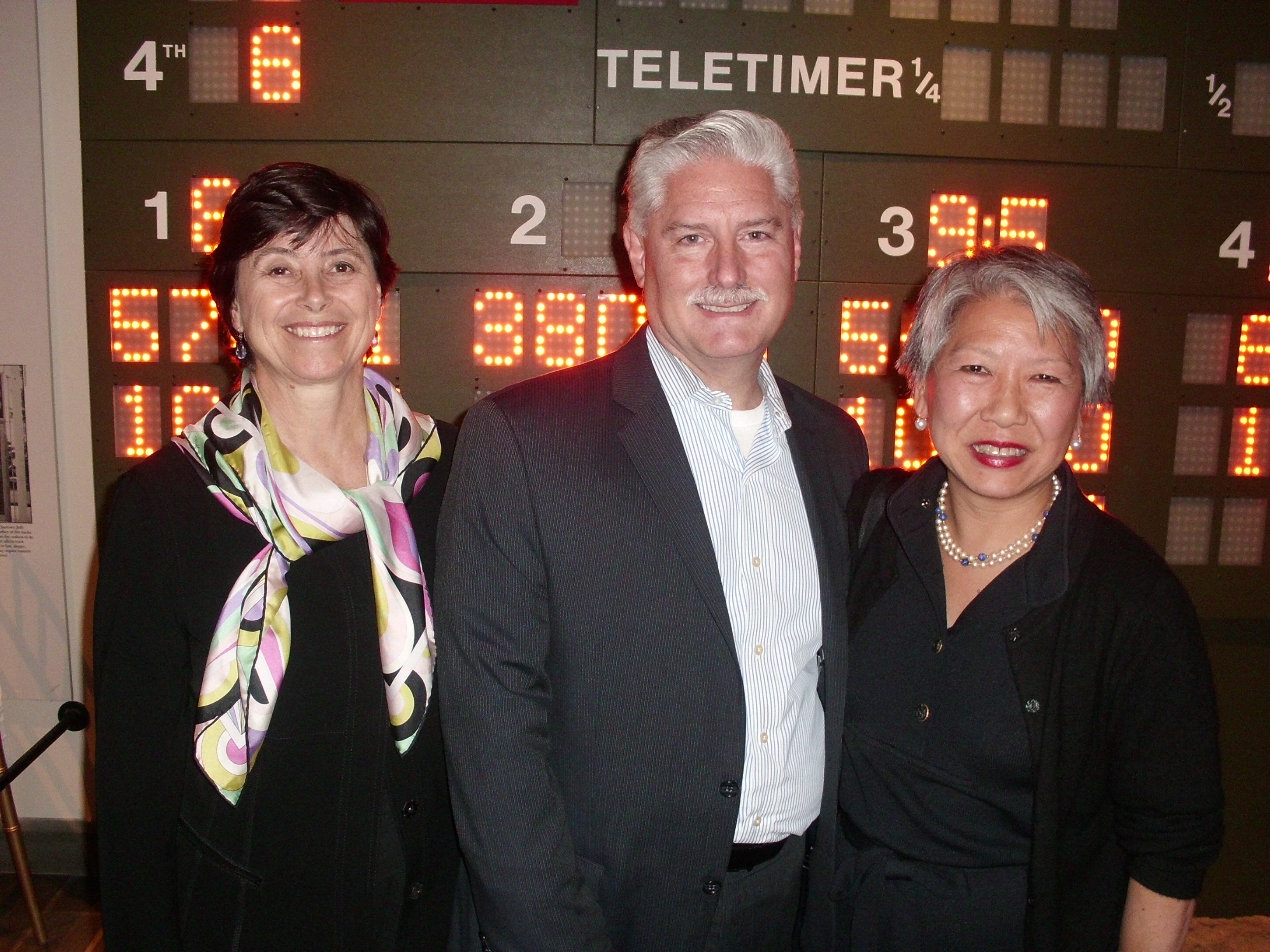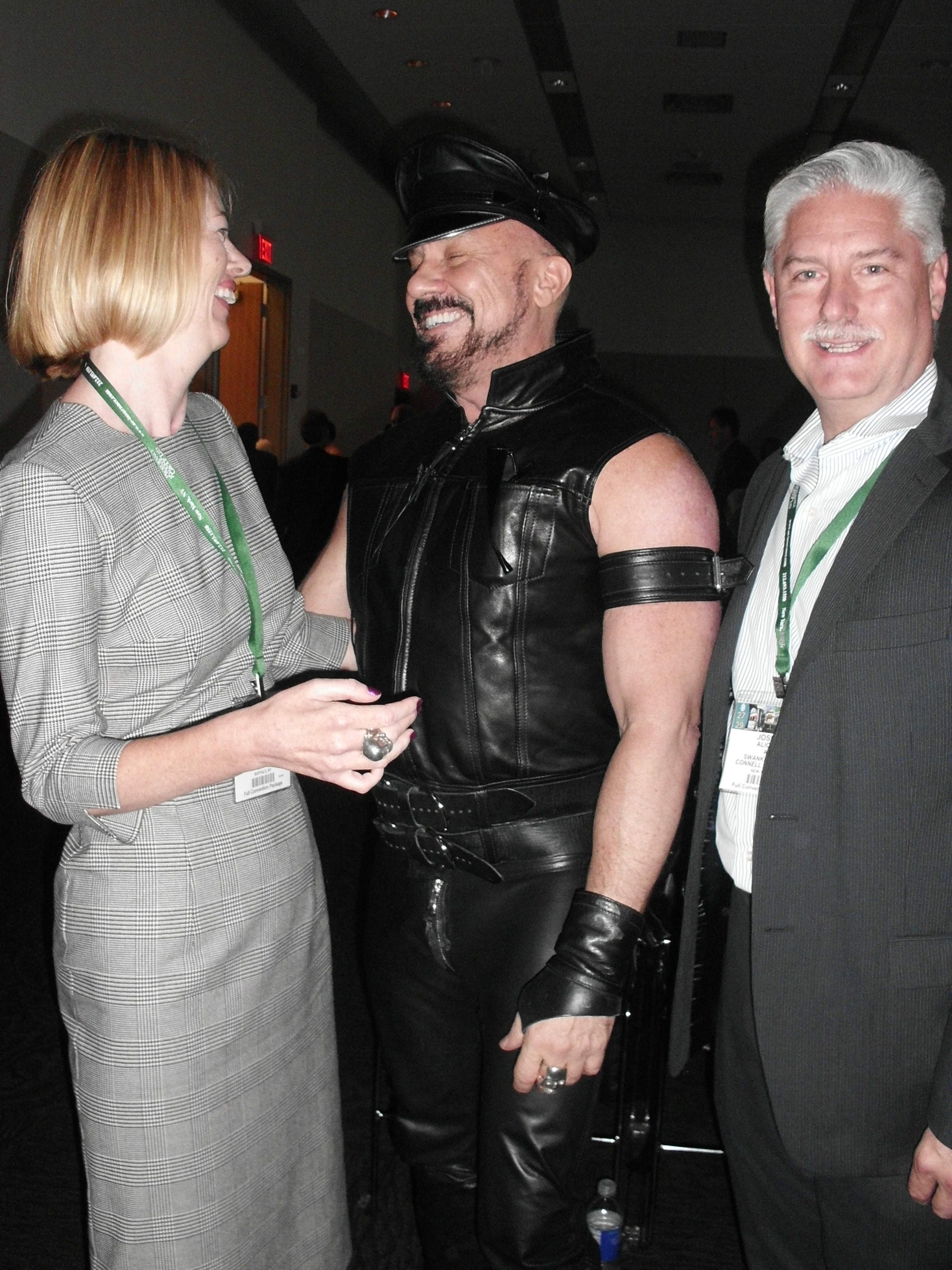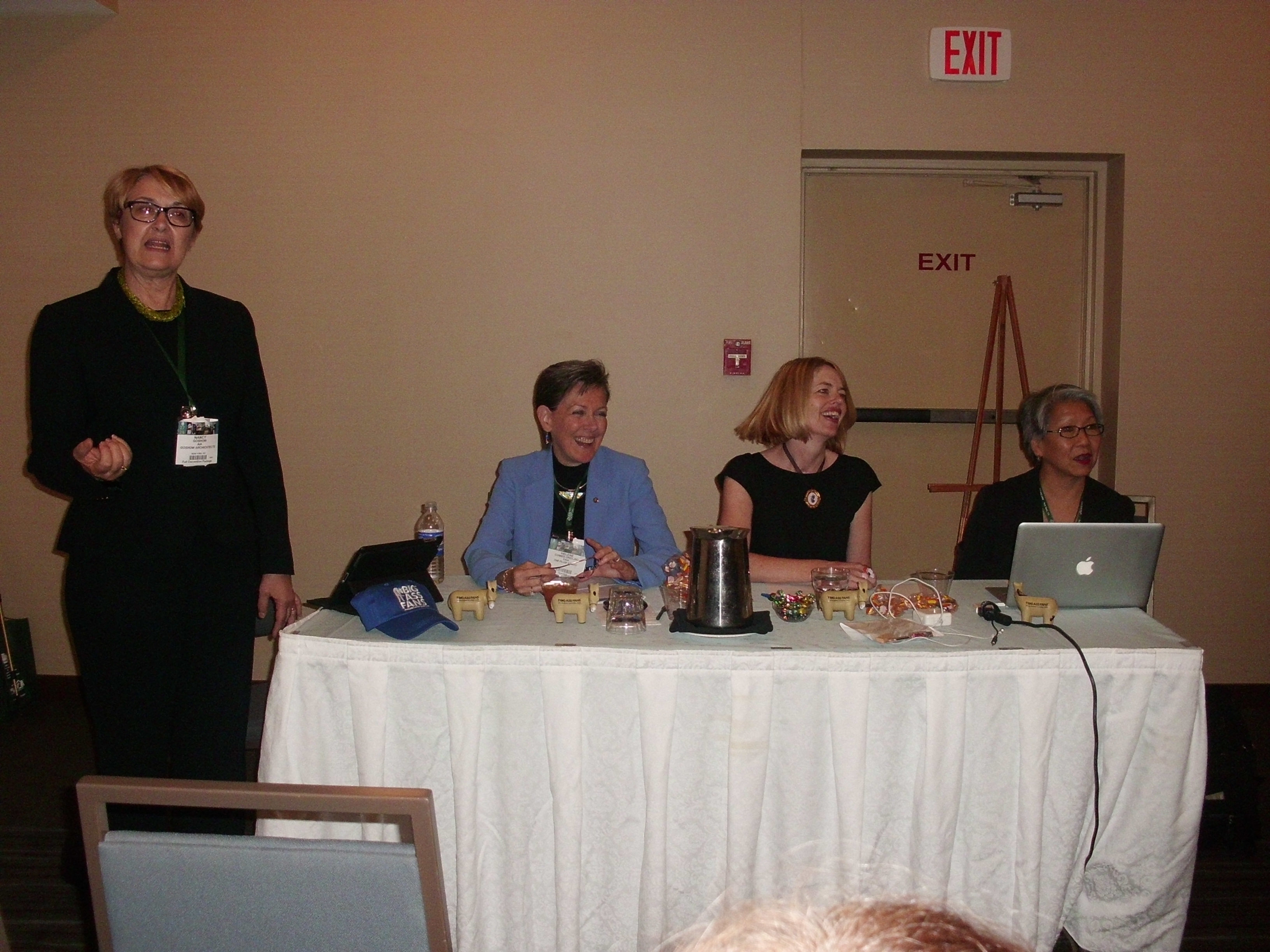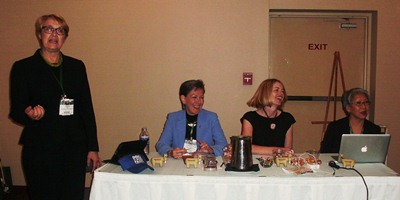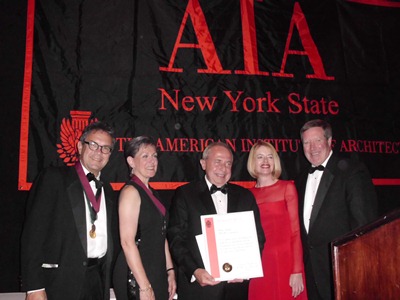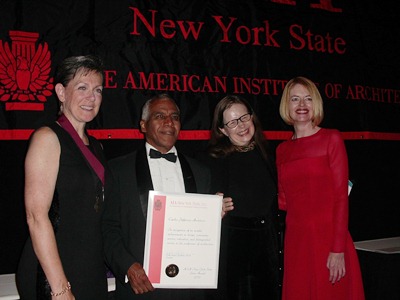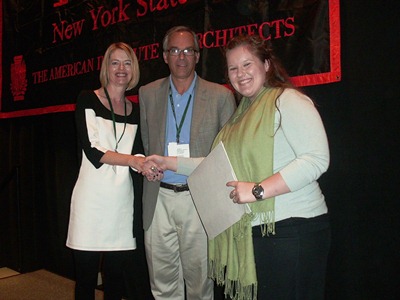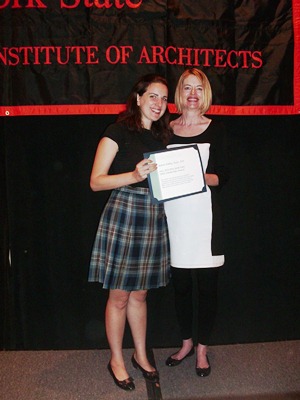by: Rick Bell FAIA Executive Director AIA New York
People generally go to Saratoga for the waters, the racing, or for Skidmore College. Last month there was another reason: the AIA New York State Convention, held at the Hilton downtown near Caroline Street. We’ll come back to Caroline Street – and return to Saratoga, especially since it is possible to go up and back on one of the best trains in the country. Amtrak – who knew? – has a “superliner” or “VistaDome” car north of Albany on the route to Montreal. A glazed-roof train car provided Mary Burke, FAIA, Margaret Castillo, AIA, Abby Suckle, FAIA, and this correspondent an utterly new and different vantage point of the fall foliage, the bucolic landscape, and the upper Hudson. Starting a trip to a congregation of AIA stalwarts in this unconventional manner put the sojourn in an entirely different perspective. The AIA New York Chapter delegation was spearheaded by 2012 President Joseph J. Aliotta, AIA, and President-elect Jill Lerner, FAIA.
The opening reception took place at the extraordinary National Museum of Racing. With a collection of racing memorabilia, artifacts, and artwork, the museum also had everything from a real starting gate to a skeleton of a horse in motion.
The 30th AIANYS Annual Convention was organized by AIANYS Past President David Businelli, AIA, along with Dan Wilson, AIA, David Pacheco, AIA, and Jeffrey Morris, AIA, from AIA Eastern New York. It was animated by the robust presence of Kelly Hayes McAlonie, AIA, and the communication skills of President-elect Eric Goshow, AIA. Three extraordinary keynote speakers punctuated the three days. The first of the lectures, “Building an International Practice,” was given by Peter Marino, FAIA, looking hip and hungry in black leather. He shared war stories, anecdotes, and tips, such as “speak the language,” while describing how his practice has succeeded in countries all over the world. When one’s clients are the major fashion houses of the world – think Chanel – hanging with celebrities doesn’t hurt, nor does being on the cover of L’Uomo Vogue back in December 2009. Peter’s advice, however, was relevant to firms small and large, no matter what their client base. It dealt with empathy, outreach, and flair – distinguishing characteristics of his career and that of others who would wish to succeed in the global economy.
Bracketing the opener was the closing keynote by Eric Cesal, who studied architecture at Washington University in St. Louis and has worked in Haiti with Architecture for Humanity. The author of Down Detour Road, Eric spelled out the steps by which architects and designers can engage their communities to make a difference. The third impressive keynote was by Billy Procida, president of Procida Advisors LLC, who suggested that architects “crossover to the other side” and test their skills at development.
Of the 44 programs, two that particularly stood out were on areas of practice. One, by Robert Lopez, RA, head of the State Board of Architecture in the Office of the Professions of the New York State Education Department, was called “Understanding Permissible Corporate Entities and the New Design Professional Corporation Laws in NYS.” It packed the room with those eager to learn more about the implications of recent changes in State regulations pertaining to firm ownership, and the basic tenets of the corporate practice prohibitions in New York.
Nancy Goshow, AIA, longtime co-chair of the AIANY Women in Architecture Committee, organized a panel discussion that brought together Helene Combs Dreiling, FAIA, Kelly Hayes McAlonie, AIA, and Susan Chin, FAIA. Helene is newly elected as AIA’s national president for 2014; Kelly, apart from her AIANYS leadership, is interim assistant vice president in the Capital Planning Group of the University of Buffalo; and Susan heads the Design Trust for Public Space, and was recently elected an AIA National Vice President. Issues discussed included gender and generational perspectives, and the change in the nature of architectural employment in private sector firms, academia, and public agencies. Despite the fact that currently women comprise 40% of enrollees in schools of architecture, only 25% of architects in this country are women, and 17% are AIA members. This panel of accomplished architects discussed the challenges of being women in practice, at home and in the AIA. The first questions came from some of the men in the room, including former AIANY Presidents Walter Hunt, FAIA, and Tony Schirripa, FAIA. The most important concluding remarks, however, came from Nicolette Feldser, Assoc. AIA, the associate director on the AIANYS Board, who noted that the Convention was poorly attended by younger members. Costly and largely mid-week, many Associates who might have benefited from the discussions and debates were effectively locked out. Maybe this can change in Syracuse next year – so save the dates of September 25-27, 2013.
The Convention’s trade show brought 89 vendors and distributors to Saratoga whose products or services were new to many architects attending. Many of those taking booths from upstate companies were relatively unfamiliar, but very accessible – for example Hubbell Galvanizing. Familiar faces with new technologies to offer included folks from Marvin Windows, Oldcastle, and Schindler, among many others. It was gratifying to see downstate companies, such as B&B Sheet Metal from Long Island City, represented by Gretchen Cobb, engaging with those specializing in preservation practice in New York City. The most sought-after giveaway of the show, apart from product information necessary for our designs, was the elegant umbrella from Belgium-based Buzon Pedestal International; with its canvas case and “brelli” logo, it came in handy during the misty weekend.
Business of a different order was conducted at both the AIANYS Board Meeting and subsequent Annual Meeting. At the former, the State Component’s Strategic Plan was formally adopted. Described as a “living document,” it will undoubtedly be seen in conjunction with the developing “repositioning” endeavor of AIA National.
At the Annual Meeting, Raymond Beeler, AIA, was elected to be 2014 AIANYS President in an uncontested election that testified to the respect he has garnered as the Board’s Vice President of Public Advocacy. The replacement for Ray Beeler as VP will be Mary Burke, FAIA, whose campaign speech and thoughtful reflections on priorities of engagement helped assure her election despite the qualifications and service of Randolph Collins, AIA, who promises to stay involved with outreach efforts. Mary and Randy worked together on the design of the new office space for AIA New York State in downtown Albany.

Sarah Caples, AIA, and Everardo Jefferson, AIA, receiving award from Kelly Hayes McAlonie, AIA, and Helene Combs Dreiling, FAIA.
Rick Bell, FAIA
Service awards were conferred to many AIANY Chapter members throughout the three day convention. These included Caples Jefferson (Firm of the Year); Julie Ann Engh, Assoc. AIA (Intern – Associate Award); Andy Frankl of Ibex Construction (Honorary AIANYS); Walter A. Hunt, Jr., FAIA (Jame William Kideney Gold Medal Award); Paul Segal, FAIA (Fellows Award); and Abby Suckle, FAIA (President’s Award). Friends of the High Line, represented at the ceremony by Erycka Montoya Pérez, won the Community Development Award. Michael Sorkin, who won the Educator Award, was not able to attend, having fractured his ankle on a slippery New York City sidewalk; his prepared remarks were abbreviated for delivery, but his regret communicated. Kate Spata also received the Student Award in absentia, as she is currently studying in Barcelona.
Student awards – and small scholarship checks augmented by an AIA National matching grant – were received by many attending NYC architectural schools, including Mia Zinni (Columbia University); Jeremy Jacinth (The Cooper Union); Robert Conway & Greg Thomas (NYIT); and Charlotte Ensign & Samuel Weston (Parsons The New School for Design). Karen Kubey, Assoc. AIA, was the first-ever recipient of the AIANYS ARE Scholarship, created to recognize Associate AIA members who have made significant contributions at an early stage in their career.
The annual black-tie gala provided the opportunity to celebrate design excellence, with many prize-winning projects designed by AIANY Chapter members, including: Adamson; Morris Adjimi; ARO; Bentel & Bentel; Cook+Fox; Cooper Joseph; CUH2A; Debra Berke; daSilva; Davis Brody Bond; François de Menil; Diller Scofidio + Renfro; Ennead Architects; Fielder Marciano; FXFOWLE; GF55; Gruzen Samton IBI Group; Handel Architects; Hanrahan Meyers; HLWInternational; Jaklitsch/Gardner; Kohn Pedersen Fox; LTL; Peter Marino; Audrey Matlock; NBBJ; Pei Cobb Freed; Port Authority of NY & NJ; Rice+Lipka; Rockwell Group; Frederic Schwartz; SHoP Architects; Smith-Miller Hawkinson; Snøhetta; Skidmore, Owings & Merrill; Studio Garneau; Tsao+McKown; and Unitedlab.
For me, the closing highlight of the trip was the first tour I have ever taken during an AIA Convention. It was of the Saratoga Race Course, which dates back to 1847. The tour was led by Samantha Bosshart of the Saratoga Springs Preservation Foundation, Charles Wheeler, Jr., manager of Planning and Community Relations for the New York Racing Association, and Michael Phinney, AIA, of the Phinney Design Group. We had access from grandstand to stable, from the Woodford Reserve Lounge to the muddy practice course, where those horses not yet en route to southern fields ran for a group of architects mesmerized by the motion, standing in the rain, thinking of the Travers and the history of connection between species.
And yes, at the train station going home, it was possible to buy a bottle of Saratoga Spring Water, available since 1872.








